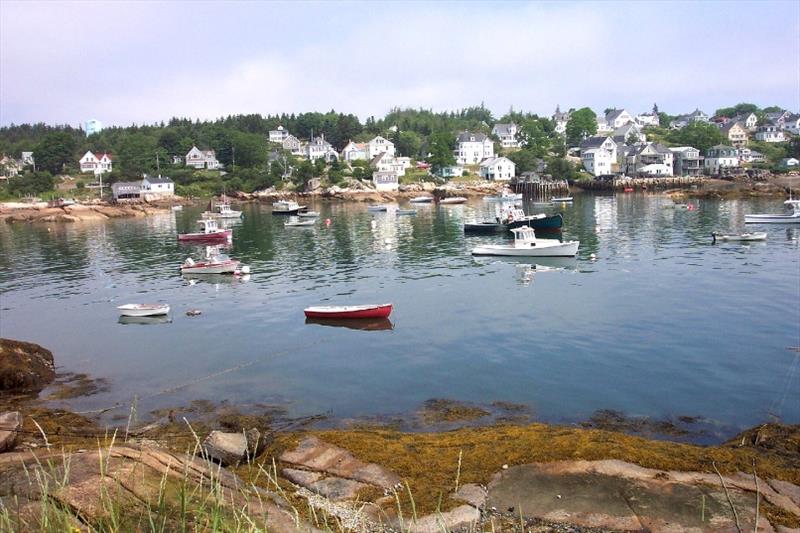
New state of the ecosystem reports document big picture around fishing
by NOAA Fisheries 13 Apr 2020 15:19 UTC

The harbor at Stonington, Maine, on the south end of Deer Isle © NOAA Fisheries
Two newly issued reports provide a snapshot of the Northeast U.S. Shelf Ecosystem. They look at everything from phytoplankton production at the bottom of the food web to the fishery harvests at the top.
One report focuses on Georges Bank and the Gulf of Maine the other on the waters of the Mid-Atlantic Bight. These are the three major regions within the Northeast U.S. Continental Shelf Large Marine Ecosystem.
"This approach has helped give the council structure with specific steps to define what our management goals and objectives are, figure out how we can address them, and understand what that means for areas such as economics," said Brandon Muffley, a fishery management specialist at the Mid-Atlantic Fishery Management Council.
These annual reports are part of a larger, ongoing NOAA-wide initiative. It provides a consistent national approach to managing ecosystems that is flexible enough to accommodate regional needs.
This Integrated Ecosystem Assessment approach is intended to help resource managers integrate physical, biological, economic, and social components of ecosystems into their decision-making.
This will help them to balance trade-offs and determine which approaches are more likely to achieve their desired goals. The 2020 State of the Ecosystem Reports inform the New England and the Mid-Atlantic Fishery Management Councils.
The State of the Ecosystem reports were produced by the Northeast Fisheries Science Center, with additional collaborators from academic research institutions, non-profit organizations, and state agencies.
For each region, the researchers organized information around management objectives — such as seafood production, stability, recreation, and ecosystem structure. They used indicators related to those objectives — including commercial and recreational landings, revenue, and diversity of fisheries and species. They will use those indicators to report on economic and social factors, protected species, fish and invertebrates, habitat quality, and ecosystem productivity.
"The State of the Ecosystem Reports are a rich tapestry of data, models and trends. They provide a unique way to assess the health of our marine environment and can inform fishery managers of the type of support/response they can expect from the ecosystem." -- John Pappalardo, chief executive officer for the Cape Cod Commercial Fishermen's Alliance, and chairman of the New England Fishery Management Council's Ecosystem-Based Fishery Management Committee.
Among the key findings of the reports:
Fisheries remove a proportion of the total energy available to the ecosystem (this is called primary production). Since 2000, the proportion of energy removed by fisheries has been declining. In the Mid-Atlantic, commercial landings have declined while primary production has remained steady. In New England, commercial landings have been steady while primary production has increased slightly.
Engagement in commercial fishing has been declining since 2004 for medium to highly engaged Mid-Atlantic fishing communities. It has been increasing in New England for moderately engaged fishing communities.
In New England, two single-species commercial fisheries — Gulf of Maine lobster and Georges Bank scallops — account for a majority of catch and revenue. Relying on single-species fisheries can be a risk to fishing communities if these populations decline.
Fish habitat modeling indicates which species are most likely to be found in current and proposed wind energy lease areas. For Mid-Atlantic managed species, summer flounder, butterfish, longfin squid, and spiny dogfish top the list. For New England managed species, Atlantic herring, little skate, winter skate, windowpane flounder, and winter flounder rank highest.
Over the last decade, marine heatwaves — periods of prolonged above-average water temperatures — have increased in intensity and duration throughout the region. Temperatures at the bottom of the ocean are also warming.
Coastal habitats are under stress in the Mid-Atlantic. Heavy rains in 2018-2019 degraded Chesapeake Bay water quality, increasing oyster mortality and spreading invasive catfish. Sea-level rise is also altering coastal habitats, driving declines in nesting seabirds on Virginia islands.
The Gulf Stream is shifting northward and is increasingly unstable, producing more warm core rings. These smaller-scale eddies break off from larger ocean currents, rotate clockwise in a ring, and circulate warm Gulf Stream water within the Northeast Shelf Ecosystem. The result is a higher likelihood of warm salty water and the appearance of associated oceanic species such as shortfin squid on the shelf.
During the last three years, the source waters flowing into the Gulf of Maine have been dominated by warm offshore waters associated with the Gulf Stream. In comparison to the past, almost no cold waters originating from the Labrador Current have entered the Gulf of Maine. The changing proportions of source water affect the temperature, salinity and nutrient inputs to the Gulf.
The reports note that changes in phytoplankton and zooplankton affect the food web. They may be related to observed changes in fish condition, recruitment patterns, and forage fish energy content. These changes, along with changing human uses, are affecting ecosystem productivity, fishing communities, and regional economies. To directly link these observations will require more work. However, the researchers say predicting how the ecosystem will respond to changes in climate and fishing patterns ultimately depends on understanding these connections.